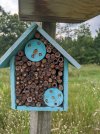I agree here in SW Arkansas. I dont see evidence of browsing on pokeweed or giant ragweedRegional preferences
Pokeweed is abundant in east texas
i have yet to see evidence of browse by deer
bill
-
If you are posting pictures, and they aren't posting in the correct orientation, please flush your browser cache and try again.
Edge
Safari/iOS
Chrome
You are using an out of date browser. It may not display this or other websites correctly.
You should upgrade or use an alternative browser.
You should upgrade or use an alternative browser.
To Plant or Not to Plant, That is the Question (When converting non-native cool season grass dominated fields to early succession plant communities)
- Thread starter BenA
- Start date
My 1.5 acre orchard area began as just a blank grass field when purchased in 2014. Here's a pic from spring of 2015, before greenup with nothing but dead grass.
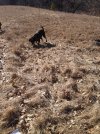
I glued it after greenup, and broadcast ladino, red, and crimson clover, and a little alfalfa. From that point I just spray cleth or gly to manage what I don't want, and mow. I like to mow when the clover has gone to seed to spread it some more. I also like to broadcast rye over the top in fall. Here's a pic from spring of 2017. I mow it before the rye goes to seed.
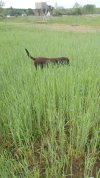
Here's a pic from 2019 with tons of good stuff growing amongst some rye.
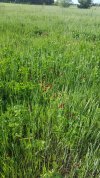
Some stuff I never seeded into it.
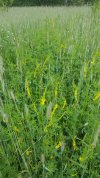
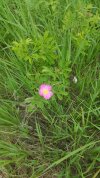
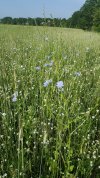
Early on I had a ton of marestail, pigweed, and ragweed. I just let them grow and do their thing. Now you can't find any. I can't find a pic but one area has several bunches of NWSG that has popped up in the last couple years.
If I had money for equipment this would most likely be soybeans, brassicas, and rye year after year. But since I had to go cheap and easy, this is what I have. Now I like it this way. And the soil has went from reddish brown sandy crap, to dark brown soil.

I glued it after greenup, and broadcast ladino, red, and crimson clover, and a little alfalfa. From that point I just spray cleth or gly to manage what I don't want, and mow. I like to mow when the clover has gone to seed to spread it some more. I also like to broadcast rye over the top in fall. Here's a pic from spring of 2017. I mow it before the rye goes to seed.

Here's a pic from 2019 with tons of good stuff growing amongst some rye.

Some stuff I never seeded into it.



Early on I had a ton of marestail, pigweed, and ragweed. I just let them grow and do their thing. Now you can't find any. I can't find a pic but one area has several bunches of NWSG that has popped up in the last couple years.
If I had money for equipment this would most likely be soybeans, brassicas, and rye year after year. But since I had to go cheap and easy, this is what I have. Now I like it this way. And the soil has went from reddish brown sandy crap, to dark brown soil.
Brian662
5 year old buck +
That looks awesome, great job!My 1.5 acre orchard area began as just a blank grass field when purchased in 2014. Here's a pic from spring of 2015, before greenup with nothing but dead grass.
View attachment 39974
I glued it after greenup, and broadcast ladino, red, and crimson clover, and a little alfalfa. From that point I just spray cleth or gly to manage what I don't want, and mow. I like to mow when the clover has gone to seed to spread it some more. I also like to broadcast rye over the top in fall. Here's a pic from spring of 2017. I mow it before the rye goes to seed.
View attachment 39975
Here's a pic from 2019 with tons of good stuff growing amongst some rye.
View attachment 39986
Some stuff I never seeded into it.
View attachment 39987
View attachment 39988
View attachment 39989
Early on I had a ton of marestail, pigweed, and ragweed. I just let them grow and do their thing. Now you can't find any. I can't find a pic but one area has several bunches of NWSG that has popped up in the last couple years.
If I had money for equipment this would most likely be soybeans, brassicas, and rye year after year. But since I had to go cheap and easy, this is what I have. Now I like it this way. And the soil has went from reddish brown sandy crap, to dark brown soil.
yoderjac
5 year old buck +
Regional preferences
Pokeweed is abundant in east texas
i have yet to see evidence of browse by deer
bill
Here, it gets hit hard when it is young. As it matures, we see considerably less use.
Gravel Road
5 year old buck +
Funny how different things can be, based on location. Here, giant ragweed is heavily browsed, even with ag all around. I've never noticed pokeweed being browsed either, but I think that's because it's hard to see the small plants. Yesterday I saw a buck eating the heads of sumac, which I've never personally witnessed.I agree here in SW Arkansas. I dont see evidence of browsing on pokeweed or giant ragweed
Native Hunter
5 year old buck +
Here is another thing to consider in this discussion - some of the seed you buy from a first class vendor could very well have superior genetics compared to what can come out of a seed-bank.
The best example I can think of is partridge pea. The native partridge pea in my area never gets even to knee high. It lacks enough aggressiveness to compete with other plants. Usually I will see just a few of these plants at the edge of a road or field edge. However, the variety of PP that I got from Roundstone Native Seeds grows 7 feet high and is one of the dominant annuals in the prairie. For my management strategy, this is highly desirable. No disking or anything else is required for it to come back year after year. Plus, it provides excellent food and cover.
Another example is little bluestem. Lots of little bluestem will not get much over knee high, but what we drilled in from Roundstone gets well over 5 feet and close to 6 feet in some places.
The moral of this story is that there is such a thing as superior genetics in the plant kingdom, but you rarely hear this mentioned for NWSGs.
The best example I can think of is partridge pea. The native partridge pea in my area never gets even to knee high. It lacks enough aggressiveness to compete with other plants. Usually I will see just a few of these plants at the edge of a road or field edge. However, the variety of PP that I got from Roundstone Native Seeds grows 7 feet high and is one of the dominant annuals in the prairie. For my management strategy, this is highly desirable. No disking or anything else is required for it to come back year after year. Plus, it provides excellent food and cover.
Another example is little bluestem. Lots of little bluestem will not get much over knee high, but what we drilled in from Roundstone gets well over 5 feet and close to 6 feet in some places.
The moral of this story is that there is such a thing as superior genetics in the plant kingdom, but you rarely hear this mentioned for NWSGs.
yoderjac
5 year old buck +
Here is another thing to consider in this discussion - some of the seed you buy from a first class vendor could very well have superior genetics compared to what can come out of a seed-bank.
The best example I can think of is partridge pea. The native partridge pea in my area never gets even to knee high. It lacks enough aggressiveness to compete with other plants. Usually I will see just a few of these plants at the edge of a road or field edge. However, the variety of PP that I got from Roundstone Native Seeds grows 7 feet high and is one of the dominant annuals in the prairie. For my management strategy, this is highly desirable. No disking or anything else is required for it to come back year after year. Plus, it provides excellent food and cover.
Another example is little bluestem. Lots of little bluestem will not get much over knee high, but what we drilled in from Roundstone gets well over 5 feet and close to 6 feet in some places.
The moral of this story is that there is such a thing as superior genetics in the plant kingdom, but you rarely hear this mentioned for NWSGs.
Very true, but also consider that often the seed in the local seed bank is well adapted for the soils, climate, and other factors...Which is why it is there....
Native Hunter
5 year old buck +
Very true, but also consider that often the seed in the local seed bank is well adapted for the soils, climate, and other factors...Which is why it is there....
That’s what Roundstone refers to as ecotype seed. That is common knowledge throughout the seed industry. But even within ecotype seed there can be improved cultivars. Sorry you didn’t know that Jack, and glad I was able to educate you.
yoderjac
5 year old buck +
I wasn't disputing that. Just pointing out that while in some cases, an "improved" cultivar developed in one area, may be a disadvantaged cultivar in another.That’s what Roundstone refers to as ecotype seed. That is common knowledge throughout the seed industry. But even within ecotype seed there can be improved cultivars. Sorry you didn’t know that Jack, and glad I was able to educate you.
BenA
5 year old buck +
Roundstone is where I got my seed from last year. I'm looking forward to seeing what pops up this year. For that 6.5 acres that I just got, I found a local farmer that said he is going to see about putting it in corn this year and him keeping all the corn in exchange for mowing some firebreaks and my plots next month. If he doesn't think he can make that work, I'm going to nuke what there is of fescue there and let mother nature take its course. I'll spot spray the stuff I don't like. It will be an interesting experiment on seedbank regeneration vs planted for sure.Here is another thing to consider in this discussion - some of the seed you buy from a first class vendor could very well have superior genetics compared to what can come out of a seed-bank.
The best example I can think of is partridge pea. The native partridge pea in my area never gets even to knee high. It lacks enough aggressiveness to compete with other plants. Usually I will see just a few of these plants at the edge of a road or field edge. However, the variety of PP that I got from Roundstone Native Seeds grows 7 feet high and is one of the dominant annuals in the prairie. For my management strategy, this is highly desirable. No disking or anything else is required for it to come back year after year. Plus, it provides excellent food and cover.
Another example is little bluestem. Lots of little bluestem will not get much over knee high, but what we drilled in from Roundstone gets well over 5 feet and close to 6 feet in some places.
The moral of this story is that there is such a thing as superior genetics in the plant kingdom, but you rarely hear this mentioned for NWSGs.
Last edited:
Native Hunter
5 year old buck +
Roundstone is where I got my seed from last year. I'm looking forward to seeing what pops up this year. For that 6.5 acres that I just got, I found a local farmer that said he is going to see about putting it in corn this year and him keeping all the corn in exchange for mowing some firebreaks and my plots next month. If he doesn't think he can make that work, I'm going to nuke what there is of fescue there and let mother nature take its course. I'll spot spray the stuff I don't like. It will be an interesting experiment on seedbank regeneration vs planted for sure.
Sounds like a good plan Ben. I hope it all works out well for you.

